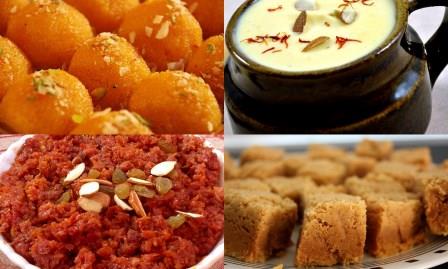 “Kuch meetha ho jae”, is a phrase most Indians use after a delicious meal, meaning – let us have something sweet. The sweet-tooth of every Indian has a connection to the pages of history. Indulging in any one of the must-eat Indian sweets after a hearty meal is a tradition. Moreover, sweets are not only just desserts; they are a way of life. They have been incorporated in every kind of celebration possible, be it a religious one or a personal ceremony. Sweets have made their position as a snack and a compulsory serving when a guest comes home. After all, it is believed that a guest is equivalent to God. Speaking of God, no religious festivity is ever complete without offerings to God and most of the offerings consist of sweets.
“Kuch meetha ho jae”, is a phrase most Indians use after a delicious meal, meaning – let us have something sweet. The sweet-tooth of every Indian has a connection to the pages of history. Indulging in any one of the must-eat Indian sweets after a hearty meal is a tradition. Moreover, sweets are not only just desserts; they are a way of life. They have been incorporated in every kind of celebration possible, be it a religious one or a personal ceremony. Sweets have made their position as a snack and a compulsory serving when a guest comes home. After all, it is believed that a guest is equivalent to God. Speaking of God, no religious festivity is ever complete without offerings to God and most of the offerings consist of sweets.
Sweet marts sprout like lamp posts along the streets and alleys of India. Some of the ‘dhabas’ have an extension for display of sweets of different variety. Colour, flavour, texture and aroma, you name it and there is one sweet which will match your craving. It is a very difficult job to choose a few sweets from the never ending list of sugary dishes. Let us try few of those delicacies that you must not miss if you are visiting India.
In most Hindu tradition, sweet actually starts the journey of a person’s life in the food world. It is called the ‘annaprashana’. Annaprashana is when a child is fed with Kheer or Payasam. The traditional delicacy is prepared with rice and milk boiled with sugar or jaggery till it condenses to a semi solid consistency. Payasam/payesh/kheer has its variations in different states of the country. Instead of rice, semolina or vermicelli is also used to make the dish. Dried fruits and nuts are added to enhance its texture, making this a delicious sweet bowlful. When the voyage of food-world starts with such a sweet delicacy, then there is no doubt that ‘life’ is bound to be one sweet journey.
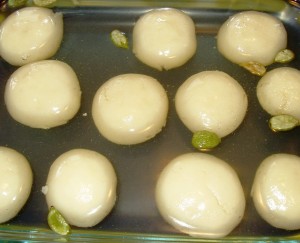 Having one kind of sweet in India would just be scratching the surface of the immense wealth of dulcet treasures. Not playing favouritism here, somehow the eastern zone, especially West Bengal becomes the sweet centre of India. Bengali food can never be complete without a delicious sweet dish. Almost as if they follow a motto of “a sweet a day keeps the doctor away”. The famous and well-loved sweet of this zone is the Rosogolla. ‘Ros’ or ‘rosh’ meaning syrup and ‘golla’ meaning balls, this sweet is just that. It is made of drained cottage cheese balls, boiled in sugar syrup. These spongy spheres are so tempting; it’s almost as if they are begging to be tasted. During winter, jaggery made of date sap gets added to the syrup, adding an intense flavour and aroma. During weddings, you would find barrels (drums) full of Rosogollas, kept for the sole purpose of “Rosogolla eating competitions” where people compete to see who can eat how many! Once the madness begins, popping in up to 20 or 40 Rosogollas is very normal.
Having one kind of sweet in India would just be scratching the surface of the immense wealth of dulcet treasures. Not playing favouritism here, somehow the eastern zone, especially West Bengal becomes the sweet centre of India. Bengali food can never be complete without a delicious sweet dish. Almost as if they follow a motto of “a sweet a day keeps the doctor away”. The famous and well-loved sweet of this zone is the Rosogolla. ‘Ros’ or ‘rosh’ meaning syrup and ‘golla’ meaning balls, this sweet is just that. It is made of drained cottage cheese balls, boiled in sugar syrup. These spongy spheres are so tempting; it’s almost as if they are begging to be tasted. During winter, jaggery made of date sap gets added to the syrup, adding an intense flavour and aroma. During weddings, you would find barrels (drums) full of Rosogollas, kept for the sole purpose of “Rosogolla eating competitions” where people compete to see who can eat how many! Once the madness begins, popping in up to 20 or 40 Rosogollas is very normal.
 The next house hold name in sweet industry of east India is the Sondesh or Sandesh. This is a moulded cottage cheese presentation with two textures. One is a little hard called the ‘kora pak’ and one is soft called the ‘norom pak’. Often slivers of almond or pistachios adorn the top of this. Modern flavours like chocolate or fruit flavours of the season, has given the Sondesh a new look and taste. Similar to the Rosogolla, the aromatic flavour of jaggery, made of date sap is predominant in this sweet during winter.
The next house hold name in sweet industry of east India is the Sondesh or Sandesh. This is a moulded cottage cheese presentation with two textures. One is a little hard called the ‘kora pak’ and one is soft called the ‘norom pak’. Often slivers of almond or pistachios adorn the top of this. Modern flavours like chocolate or fruit flavours of the season, has given the Sondesh a new look and taste. Similar to the Rosogolla, the aromatic flavour of jaggery, made of date sap is predominant in this sweet during winter.
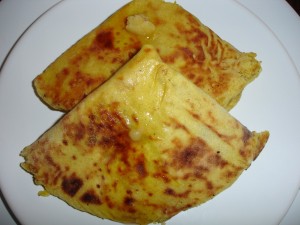 When the salty breeze of the Arabian Sea hits the coast, the mind travels to a sweet place. The western part of this country boasts of sweet dishes like the Puran Poli. A festivity surrounded dish, made with jaggery flavoured boiled lentils stuffed into a dough ball. The dough is then rolled out and pan fried. This plate of sweet bread is eaten with cream, mango pulp or Shrikhand. Puran Poli is also enjoyed without any toppings as it has a delectable taste. It is well worth the effort to make this sweet dish.
When the salty breeze of the Arabian Sea hits the coast, the mind travels to a sweet place. The western part of this country boasts of sweet dishes like the Puran Poli. A festivity surrounded dish, made with jaggery flavoured boiled lentils stuffed into a dough ball. The dough is then rolled out and pan fried. This plate of sweet bread is eaten with cream, mango pulp or Shrikhand. Puran Poli is also enjoyed without any toppings as it has a delectable taste. It is well worth the effort to make this sweet dish.
 Shrikhand, a popular curd-based Gujarati sweet dish from Western India, is creamy and cool, a perfect feature for the hot summer days. Strained yogurt is whipped in with the aroma and simple flavour of ‘kesar’ (saffron). To adjust to the different tastes of the multitude, Shrikhand is also prepared with other flavours like cardamom, mango etc. Shrikhand is found in almost every supermarket today, though nothing beats the fresh homemade Shrikhand.
Shrikhand, a popular curd-based Gujarati sweet dish from Western India, is creamy and cool, a perfect feature for the hot summer days. Strained yogurt is whipped in with the aroma and simple flavour of ‘kesar’ (saffron). To adjust to the different tastes of the multitude, Shrikhand is also prepared with other flavours like cardamom, mango etc. Shrikhand is found in almost every supermarket today, though nothing beats the fresh homemade Shrikhand.
 Visiting Maharashtra and not having Modak would be sacrilegious. Modak is a sweet dumpling in the shape of a ribbed water drop with a surprise in the centre. It is made of rice flour usually steamed and sometimes fried, with a core of fresh coconut and jaggery. A festival time favourite, as it is believed that Lord Ganesha, the God with elephant head, favoured this sweet. You can very well imagine that a sweet which is loved by the Gods, is going to be an absolute favourite of yours too!
Visiting Maharashtra and not having Modak would be sacrilegious. Modak is a sweet dumpling in the shape of a ribbed water drop with a surprise in the centre. It is made of rice flour usually steamed and sometimes fried, with a core of fresh coconut and jaggery. A festival time favourite, as it is believed that Lord Ganesha, the God with elephant head, favoured this sweet. You can very well imagine that a sweet which is loved by the Gods, is going to be an absolute favourite of yours too!
 Have you ever felt the sweet knots of love? How about tasting them? Swirls of batter, deep fried and soaked in crystalline sugar syrup, result into a delectable, chewy sweet, parallel to none and it is called the Jalebis. Hot or cold with yogurt, ice-cream, rabdi or just solo, have it the way you want. Jalebi is used as a synonym of sweet entangled relationships, quite understandable.
Have you ever felt the sweet knots of love? How about tasting them? Swirls of batter, deep fried and soaked in crystalline sugar syrup, result into a delectable, chewy sweet, parallel to none and it is called the Jalebis. Hot or cold with yogurt, ice-cream, rabdi or just solo, have it the way you want. Jalebi is used as a synonym of sweet entangled relationships, quite understandable.
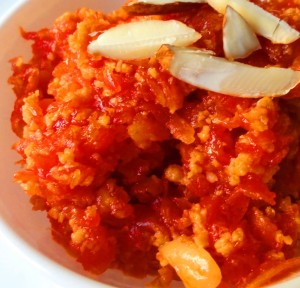 Veggies in sweets, can that be possible? Absolutely! The spectacular Gajar Ka Halwa is the answer to that question. Halwa, in general, is made from semolina or even ground lentils, but Gajar Ka Halwa is a winter favourite. Fresh sweet carrots are grated and cooked in milk with sugar and clarified butter. Punctuated with nuts and raisins, Gajar Ka Halwa is enjoyed hot, as each spoonful dissolves on the tongue, leaving you asking for the next.
Veggies in sweets, can that be possible? Absolutely! The spectacular Gajar Ka Halwa is the answer to that question. Halwa, in general, is made from semolina or even ground lentils, but Gajar Ka Halwa is a winter favourite. Fresh sweet carrots are grated and cooked in milk with sugar and clarified butter. Punctuated with nuts and raisins, Gajar Ka Halwa is enjoyed hot, as each spoonful dissolves on the tongue, leaving you asking for the next.
While talking about Indian sweets, how can we miss mentioning some lovely sweets special to the land of divine temples and Nawabs? When you visit the southern states of India and particularly the lands of the Nawabs, don’t forget to try their treasure of sweet dishes. Like their history, the southern Nawabs had a rich taste in food; obviously their sweets were no exceptions. Qubani ka Meetha is a dish made of dried apricots. ‘Qubani’ is the Urdu name for apricot. Decadent apricots are boiled in milk till they reach a thick consistency and then dressed with almonds and apricot kernel. Often served with ‘malai’ (fresh cream), ice-cream or custard, this meetha is a sure hit in most of the weddings in Hyderabad.
The royal feeling reflects in Double Ka Meetha too, also known as the Shahi Tukdi. Made of bread pieces toasted in clarified butter and finally settled in a pool of condensed milk, how much more rich can this get? Wait, there is more. Chopped nuts sprinkled on top give it the extra crunch and richness.
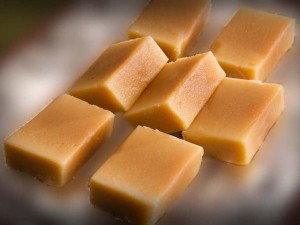 Mysore the city of palaces has a sweet named after it. Mysore Pak is a sweet made of gram flour, sugar and lots of ghee (clarified butter). There is a generous dose of legend surrounding the conception of this sweet. It was said to have originated in the palace kitchen by a cook named Kakasura Madappa. The royalty fell in love with this treat and asked the name of the dish. Having just invented the sweet, he just replied “Mysore Pak”. An experiment by the royal cook gave us a delicious sweet to enjoy forever.
Mysore the city of palaces has a sweet named after it. Mysore Pak is a sweet made of gram flour, sugar and lots of ghee (clarified butter). There is a generous dose of legend surrounding the conception of this sweet. It was said to have originated in the palace kitchen by a cook named Kakasura Madappa. The royalty fell in love with this treat and asked the name of the dish. Having just invented the sweet, he just replied “Mysore Pak”. An experiment by the royal cook gave us a delicious sweet to enjoy forever.
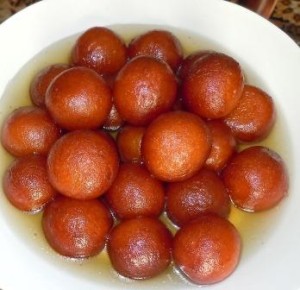 From the rest of the country there are many more sweets and it will be practically impossible to name each one of it. For that a visit to each region would be an ideal way of exploring the many sweets each region has to offer. But to make this sweet journey memorable we must mention Gulab Jamun here. These brown balls of spongy sweets are laden with sugary liquid. Made of flour and khoya, fried and then dipped into a hot bath of sugar syrup, Gulab Jamuns are a must-eat sweet of India. Soaking in all the sweet nectar the Jamuns are temptation personified.
From the rest of the country there are many more sweets and it will be practically impossible to name each one of it. For that a visit to each region would be an ideal way of exploring the many sweets each region has to offer. But to make this sweet journey memorable we must mention Gulab Jamun here. These brown balls of spongy sweets are laden with sugary liquid. Made of flour and khoya, fried and then dipped into a hot bath of sugar syrup, Gulab Jamuns are a must-eat sweet of India. Soaking in all the sweet nectar the Jamuns are temptation personified.
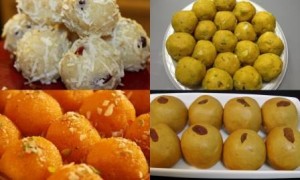
Summing up the entire sacchariferous exploration of the enchanting country of India, we come to Laddoo or Laddu. Songs and poems of this particular sweet are rampant. Laddu comes in different avatars. There are Motichur, Danedar, Rava, Besan, Ragi, Boondi and Mallai Laddus. The different ingredients used to compose this luscious sweet, makes the Laddu a versatile and well enjoyed course. Originated from the Sanskrit word of ‘lattika’ or ‘ladduka’ meaning small balls, Laddu is a favourite dessert and one of the most common offering to the Gods.
Whatever is the season or occasion and wherever you are on the land of the Maharajas’, sweets is the way to go. Each sweet has its unique way to please and satisfy you. A euphoric sojourn of the dulcet kind will be one of the best memories in your journal of desserts.


